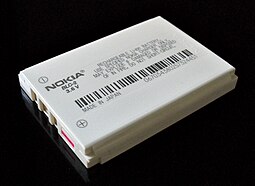Lithium-ion battery
Appearance
 An example o a Li-ion battery (uised on the Nokia 3310 mobile phone) | |
| Speceefic energy | 100–265 W·h/kg[1][2] (0.36–0.875 MJ/kg) |
|---|---|
| Energy density | 250–676 W·h/L[3] (0.90–2.43 MJ/L) |
| Speceefic pouer | ~250-~340 W/kg[1] |
| Chairge/dischairge efficiency | 80–90%[4] |
| Energy/consumer-price | 2.5 W·h/US$[5] |
| Sel-dischairge rate | 8% at 21 °C 15% at 40 °C 31% at 60 °C (per month)[6] |
| Cycle durability | 400–1200 cycles [7] |
| Nominal cell voltage | NMC 3.6 / 3.8 V, LiFePO4 3.2 V |
A lithium-ion battery (whiles Li-ion battery or LIB) is a member o a faimily o rechairgeable battery teeps in which lithium ions muive frae the negative electrode tae the positive electrode during dischairge an back when chairgin.
References
[eedit | eedit soorce]- ↑ a b "Rechargeable Li-Ion OEM Battery Products". Panasonic.com. Archived frae the original on 13 Apryle 2010. Retrieved 23 Apryle 2010. Unknown parameter
|deadurl=ignored (help) - ↑ "Panasonic Develops New Higher-Capacity 18650 Li-Ion Cells; Application of Silicon-based Alloy in Anode". greencarcongress.com. Retrieved 31 Januar 2011.
- ↑ "NCR18650B" (PDF). Panasonic. Archived frae the original (PDF) on 2015-07-22. Retrieved October 2015. Check date values in:
|accessdate=(help) - ↑ Valøen, Lars Ole and Shoesmith, Mark I. (2007). The effect of PHEV and HEV duty cycles on battery and battery pack performance (PDF). 2007 Plug-in Highway Electric Vehicle Conference: Proceedings. Retrieved 11 June 2010.
- ↑ Lawson Barrie Electrochemical Energy[deid airtin] Woodbank Communications Ltd
- ↑ Abe, H.; Murai, T.; Zaghib, K. (1999). "Vapor-grown carbon fiber anode for cylindrical lithium ion rechargeable batteries". Journal of Power Sources. 77 (2): 110–115. doi:10.1016/S0378-7753(98)00158-X.
- ↑ Battery Types and Characteristics for HEV Archived 2015-05-20 at the Wayback Machine ThermoAnalytics, Inc., 2007. Retrieved 11 June 2010.
